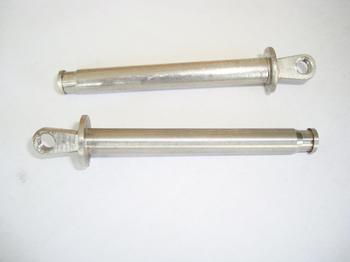 As environmental concerns continue to rise, sustainability has become a top priority for both individuals and industries. Governments around the world are pushing for energy efficiency and emissions reduction, and the hardware sector is no exception. The increasing pressure to reduce carbon footprints has led to a transformation in how hardware products are designed, manufactured, and used.
In recent years, the home appliance industry has seen a shift from traditional manufacturing methods to more sustainable practices. Energy-saving and eco-friendly hardware accessories are now at the forefront of innovation. For instance, bathroom fixtures that conserve water or kitchen tools that use less power have gained popularity among environmentally conscious consumers. This trend not only meets regulatory requirements but also aligns with the growing demand for green living.
Hardware products can be broadly categorized into general and specialized types. General hardware includes items like hinges, slides, and locks—components that are frequently used in daily life. Specialized hardware, such as bathroom and kitchen accessories, plays a crucial role in enhancing the functionality and comfort of modern homes. As consumer expectations rise, the importance of high-quality hardware in appliances becomes more evident.
The quality of home appliances is often determined by the hardware used. Poorly designed or low-quality components can lead to inefficiency, malfunctions, or even safety issues. On the flip side, well-engineered hardware ensures smooth operation, durability, and enhanced user experience. In fact, while hardware may only account for 10% of an appliance's cost, it contributes to over 80% of its usability and satisfaction.
With the global push toward energy efficiency, many countries are implementing stricter regulations on product standards. International organizations like ISO and IEC have developed numerous green standards related to safety, energy use, and environmental impact. These standards are increasingly being adopted worldwide, making it essential for hardware manufacturers to comply with international benchmarks.
For example, the European Union’s WEEE Directive has raised recycling targets and increased the responsibility of producers to manage waste effectively. Similarly, the U.S. Energy Star program continues to expand, covering a wide range of energy-efficient products. Countries like Brazil, Mexico, and Thailand are also introducing their own energy efficiency regulations, reflecting a global movement toward greener technologies.
To keep up with these changes, hardware companies must invest in research and development, adopt cleaner production methods, and improve resource efficiency. Embracing circular economy principles—such as recycling, reusing, and reducing waste—is becoming a key strategy for long-term sustainability.
In conclusion, the hardware industry is playing a vital role in the global effort to reduce energy consumption and emissions. As technology advances and environmental awareness grows, the future of hardware will be shaped by innovation, sustainability, and a commitment to a greener planet.
As environmental concerns continue to rise, sustainability has become a top priority for both individuals and industries. Governments around the world are pushing for energy efficiency and emissions reduction, and the hardware sector is no exception. The increasing pressure to reduce carbon footprints has led to a transformation in how hardware products are designed, manufactured, and used.
In recent years, the home appliance industry has seen a shift from traditional manufacturing methods to more sustainable practices. Energy-saving and eco-friendly hardware accessories are now at the forefront of innovation. For instance, bathroom fixtures that conserve water or kitchen tools that use less power have gained popularity among environmentally conscious consumers. This trend not only meets regulatory requirements but also aligns with the growing demand for green living.
Hardware products can be broadly categorized into general and specialized types. General hardware includes items like hinges, slides, and locks—components that are frequently used in daily life. Specialized hardware, such as bathroom and kitchen accessories, plays a crucial role in enhancing the functionality and comfort of modern homes. As consumer expectations rise, the importance of high-quality hardware in appliances becomes more evident.
The quality of home appliances is often determined by the hardware used. Poorly designed or low-quality components can lead to inefficiency, malfunctions, or even safety issues. On the flip side, well-engineered hardware ensures smooth operation, durability, and enhanced user experience. In fact, while hardware may only account for 10% of an appliance's cost, it contributes to over 80% of its usability and satisfaction.
With the global push toward energy efficiency, many countries are implementing stricter regulations on product standards. International organizations like ISO and IEC have developed numerous green standards related to safety, energy use, and environmental impact. These standards are increasingly being adopted worldwide, making it essential for hardware manufacturers to comply with international benchmarks.
For example, the European Union’s WEEE Directive has raised recycling targets and increased the responsibility of producers to manage waste effectively. Similarly, the U.S. Energy Star program continues to expand, covering a wide range of energy-efficient products. Countries like Brazil, Mexico, and Thailand are also introducing their own energy efficiency regulations, reflecting a global movement toward greener technologies.
To keep up with these changes, hardware companies must invest in research and development, adopt cleaner production methods, and improve resource efficiency. Embracing circular economy principles—such as recycling, reusing, and reducing waste—is becoming a key strategy for long-term sustainability.
In conclusion, the hardware industry is playing a vital role in the global effort to reduce energy consumption and emissions. As technology advances and environmental awareness grows, the future of hardware will be shaped by innovation, sustainability, and a commitment to a greener planet.Sheet Metal Chassis And Cabinet
Suzhou Green New Material Technology Co., Ltd. , https://www.szgreenvip.com